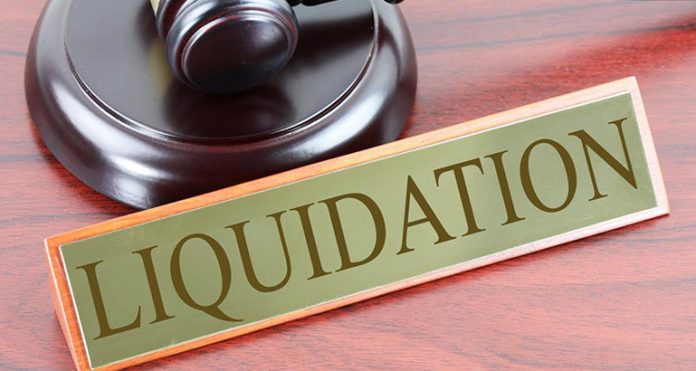This article is written by Vishakha Bhandakkar who is pursuing a Certificate course in Companies Act from Lawsikho.
Table of Contents
Introduction
Liquidation is the process in which a debt-ridden company sells its assets in order to pay off its debts to its claimants. When a liquidation order is passed, the business of the company comes to an end, which is why liquidation is considered to be the death of the company or “corporate death”. It is used as a last resort when the process of insolvency resolution fails. Being the last and final stage of a corporate entity’s life, there is no provision to convert liquidation proceedings into restructuring/rehabilitation proceedings. This article deliberates on the stages of revival of companies under liquidation, possible suspension of liquidation proceedings, and the way forward for companies facing corporate death.
What is liquidation?
The Insolvency and Bankruptcy Code, 2016 (“IBC”) and the Companies Act, 2013 (“Companies Act”) do not define the term “liquidation.” Liquidation is the process initiated when a company is under debt and is unable to overcome its liabilities and obligations. The company sells its assets and property and converts it into cash in order to pay off its debts, liabilities, and obligations to its creditors. Any surplus amount is distributed among members, owners, and shareholders. Liquidation may either be compulsory or voluntary, and the reasons for liquidation could be insolvency, bankruptcy, willingness to discontinue business, etc. Liquidation is at the end of the process of the closure of business. It closes down the company as a legal entity. The National Company Law Tribunal (“NCLT”) passes a liquidation order only in the final stage of the closure of the business of a company.
The role of IBC in the revival of a company under liquidation
The IBC contains a thorough and extensive scheme for the rehabilitation/restructuring of a company facing liquidation. These rehabilitation or restructuring proceedings are in the form of Corporate Insolvency Resolution Processes (“CIRPs”) under Chapter II of the IBC. A ‘resolution plan’ is made under the CIRP. The NCLT passes a liquidation order only when the CIRP fails.
When does a CIRP fail?
The resolution plan under the CIRP may fail due to the reasons given under Section 33 of the IBC: –
- The resolution professional informs the NCLT that the committee of creditors has, by requisite the majority of 66% voting share, decided to liquidate the company.
- The committee of creditors has not submitted a resolution plan within the limit prescribed under Section 12 of the IBC or Section 56 in case of a fast-track corporate insolvency resolution process.
- The NCLT rejects the resolution plan for non-compliance of conditions and prerequisites.
- The corporate debtor contravenes the provisions of the resolution plan approved by the NCLT.
Recourse to compromise under Section 230 of the Companies Act
Recourse can be taken to Section 230 of the Act in order to revive a company facing liquidation. By taking recourse to this Section, the liquidation proceedings evolve into rehabilitation or restructuring proceedings in order to revive a company facing corporate death. In S.C. Sekaran v. Amit Gupta & Ors, the liquidator appointed under the IBC was directed by the NCLAT to “take steps in terms of Section 230” for the revival of the corporate debtor. Section 230 allows the liquidator appointed under Section 34 of the IBC to file an application before the NCLT proposing a scheme of compromises and/or arrangements between the company and its creditors, and where applicable, its members.
Who can and cannot propose a scheme under Section 230 of the Companies Act?
According to Section 230 of the Companies Act, the company or a creditor or a member of the company or the liquidator of the company can file an application before the NCLT proposing a scheme of compromise or arrangement between the company and its members or creditors, instead of passing a resolution of liquidation
Role of Section 29A of the IBC
The National Company Law Appellate Tribunal (“NCLAT”) has held that a creditor or a member of the company who is ineligible under Section 29A of the IBC cannot propose a scheme under Section 230 of the Companies Act.
In Arun Kumar Jagatramka v. Jindal Steel and Power Ltd. & Anr., the Supreme Court held that Section 29A was inserted in the IBC in the public interest and effective corporate management and administration. It redresses a loophole in the IBC that permitted backdoor entry to the former management of the corporate debtor. It was inserted to prevent individuals from taking unfair advantage and participating in the liquidation process. It prevents such individuals from taking control of a dying corporate entity or corporate debtor. It provides a list of individuals who are ineligible to propose a scheme.
The conflict between Section 29A and Section 230
Until recently, there was ambiguity as to how Section 29A and Section 230 shall be implemented together. The NCLT had to look into the objectives and purpose of both the Sections in order to prevent the promoters from taking advantage of the liquidation proceedings. The Insolvency and Bankruptcy Board of India (“IBBI”) had invited public comments on this matter. In Jindal Steel and Power Ltd v. Arun Kumar Jagatramka & Gujarat NRE Coke Ltd, the NCLAT observed that a scheme of compromise and arrangement is not maintainable when proposed by an individual ineligible under Section 29 of the IBC. Therefore, it was held that a creditor/member ineligible under Section 29 of the IBC is disqualified from proposing a scheme before the NCLT.
Do individuals ineligible under Section 29A have the right to participate and vote in meetings?
A question arises whether the individuals ineligible under Section 29A of the IBC have a right to participate and vote in meetings of the committee of creditors and whether they are entitled to receive a notice of the meetings and copies of the scheme. The Companies Act and the IBC do not mention any eligibility criteria for participating and voting in the meetings. But the IBC, under Section 24, entitles directors and members to the notice and to participate in the meetings but does not permit them to vote in the meetings . In Vijay Kumar Jain v. Standard Chartered Bank & Ors, a question arose whether the directors who are entitled to attend the meetings are also entitled to receive copies of the resolution plans. The Supreme Court held that directors have a vital interest in the resolution plans discussed in the meetings of the committee of creditors and hence are entitled to receive notice of the meetings and copies of the plans.
Whose approval is required for a scheme?
Under Section 230(6) of the Companies Act, a scheme of arrangement and compromise requires the consent of at least 75% in value of the creditors/members or class of creditors/members, as the case may be.
What is the “class” of creditors?
The application filed before the NCLT requires the disclosure of the basis on which each class of creditors was identified for the approval of the scheme. In the Rajeev S. Mardia case, it was held that “class” in the context of liquidation would “include the classes of creditors as known to law”. Therefore, “class” of creditors may be identified as secured creditors, workmen, preferential creditors and unsecured creditors.
Implementation of the scheme
During the scheme implementation process, the liquidation order is stayed. The scheme becomes binding on the company, classes of creditors/members, the liquidator and the contributories. The order of the NCLT must be filed with the Registrar of Companies within 30 days of receipt of such order. The NCLT may impose a moratorium on the company from the formulation of the scheme to the approval of the scheme. The NCLT has powers to give directions and make modifications to the scheme, wherever it deems necessary, for the smooth and proper implementation of the scheme.
Summary procedure for winding up of companies
On 24th January 2020, the Ministry of Corporate Affairs notified the rules for the summary procedure for winding up of companies. The rules are called the Companies (Winding-up) Rules, 2020, and will have effect from 1st April 2020. The companies shall be wound up or liquidated under Section 361 of the Companies Act. The procedure is briefly discussed as follows:
Conditions
|
The company accepts deposits and the total outstanding deposits. |
Do not exceed Rs 25 lakhs. |
|
The company has loans and total outstanding loans including secured loans. |
Does not exceed Rs 50 lakhs. |
|
The total turnover of the company. |
Does not exceed Rs 50 crores. |
|
The paid-up share capital of the company. |
Does not exceed Rs 1 crore. |
Appointment of the official liquidator
The Central Government shall appoint an official liquidator.
Procedure for liquidation
Sale of assets and properties
With the prior approval of the Central Government, the liquidator shall sell the assets and properties of the company. The gross sale proceeds shall be paid to the liquidator and expenses incurred during the sale shall be covered by the liquidator from the gross sale proceeds. As per Section 349 of the Companies Act, the liquidator must pay the monies received by him in the public account of India in the Reserve Bank of India.
Payment to creditors
Within 30 days of his appointment, the liquidator shall call upon the creditors to prove their claims from the company. The creditors shall prove their claims in the prescribed manner within 30 days of receipt of the call from the liquidator. The liquidator shall then assess the claims made by the creditors. Upon expiry of the time period for proving the claims, the liquidator shall, within 30 days, file a list of creditors with the Central Government. The liquidator shall then discharge the debts and claims of the creditors.
Powers and duties of the official liquidator
The liquidator shall become the custodian of all assets and any amount due to the company. He may appoint an agent or an auctioneer for the sale of assets and property as approved by the Central Government. He shall investigate and submit a report to the Central Government regarding whether or not fraud has been committed in the affairs of the company.
Winding-up order
After examining the report submitted by the liquidator, the Central Government shall pass a winding-up order for the company.
Can a liquidation order be reversed?
A liquidation order once passed cannot be reversed. The liquidation process commences after the assets of the company have been sold and the proceeds have been distributed among the creditors and shareholders. This is when the dissolution of the company takes place. It results in the company being shut down. Liquidation order, be it voluntary or involuntary, cannot be reversed. It can only take recourse to a scheme of compromise and arrangement.
Can the Supreme Court reverse a liquidation order?
Article 142 of the Indian Constitution empowers the Supreme Court to pass any decree or order for doing complete justice in any cause or matter pending before it.
In Kamineni Steel & Power India Pvt. Ltd and Innoventive Industries Ltd. the Supreme Court upheld the NCLAT’s decision and laid emphasis on the committee of creditors’ autonomy in the approval or rejection of resolution plans based on their commercial judgment. The NCLAT directed liquidation in both cases as the resolution plans in both the cases had not been approved by the requisite majority of the committee of creditors. The Supreme Court refused to exercise its power under Article 142. Even though it does have the power to reverse a liquidation order, the Supreme Court will use it sparingly.
Measures and impact of the Corporate Insolvency and Governance Act, 2020
The Corporate Insolvency and Governance Act, 2020 (“CIGA”) was enacted to reform the United Kingdom’s insolvency laws and to facilitate failing companies in the COVID-19 pandemic. The reformation of the insolvency laws is a permanent measure whereas the facilitation of struggling companies is temporary. One such permanent measure is the moratorium for such companies.
The permanent measure of moratorium under the CIGA
The company shall have a moratorium period during which a viable restructuring plan may be sought to revive and rehabilitate the company. During such a period, the creditors shall not be allowed to exercise their rights and take action against the company without the permission of the court. The company shall be managed by its directors but under the supervision of an insolvency practitioner. This measure gives the company a “breathing space” during which it can revive itself and instead of being liquidated and subsequently closing down.
The Report of the Expert Committee on Company Law has observed the following on moratorium and suspension of proceedings:
“A limited standstill period is essential to provide an opportunity for genuine business to explore restructuring.
The law should, therefore, impose a prohibition on the unauthorized disposition of the Debtor’s assets and suspension of actions by Creditors to enforce their rights or remedies against the Debtor on the assets for a limited prescribed period to preserve and protect assets besides maximizing its value. This will facilitate unobstructed conduct of Insolvency processes by the Tribunal without having to deal with the complexities of multiple creditor debt actions in Debt Recovery Tribunals. This will also encourage creditors to participate in the Insolvency process besides achieving fair and orderly administration and upholding fundamental objectives and policy of the Insolvency Law.”
A provision similar to the moratorium introduced in the CIGA must be adapted and incorporated in the Companies Act in order to reform the provision for the schemes of compromise and arrangement. A moratorium or suspension of proceedings will give the company a breather during which it can seek revival through restructuring or a scheme of compromise and arrangement.
Conclusion
The scheme of arrangement and compromise in a liquidation proceeding is a redeeming feature for the revival of a company. Whether such a scheme takes the corporate debtor back to its pre-insolvency days, is difficult to say. This is because the liquidation order once passed cannot be reversed, the scheme only gives the company a chance of revival through compromise and arrangement. More clarity should be brought to aspects such as the mechanism of voting and approval of the scheme. This will help offset any issues which arise due to the cumbersome nature of the procedure involved in the scheme under Section 230 of the Companies Act which will ultimately benefit the companies facing liquidation.
References
- https://www.mondaq.com/india/shareholders/819864/is-liquidation-irreversible-schemes-of-compromise-or-arrangement-for-companies-in-liquidation
- https://www.obhanandassociates.com/blog/interplay-between-liquidation-proceedings-under-ibc-and-section-230-of-the-companies-act/?utm_source=Mondaq&utm_medium=syndication&utm_campaign=LinkedIn-integration
- https://vinodkothari.com/2018/09/reversibility-of-liquidation-order/#_ftn2
- https://vinodkothari.com/2019/11/schemes-under-section-230-with-a-pinch-of-section-29a/
- https://samistilegal.in/scheme-of-arrangement-during-liquidation-under-companies-act-2013/
- https://commonslibrary.parliament.uk/research-briefings/cbp-8971/
- https://www.twobirds.com/news/articles/2020/global/corporate-insolvency-and-governance-act-2020
- https://cleartax.in/s/winding-up-of-company-procedure
- https://indiacorplaw.in/wp-content/uploads/2017/07/JJ20Irani20Report-MCA.pdf
Students of LawSikho courses regularly produce writing assignments and work on practical exercises as a part of their coursework and develop themselves in real-life practical skills.
LawSikho has created a telegram group for exchanging legal knowledge, referrals, and various opportunities. You can click on this link and join:
 Serato DJ Crack 2025Serato DJ PRO Crack
Serato DJ Crack 2025Serato DJ PRO Crack











 Allow notifications
Allow notifications



